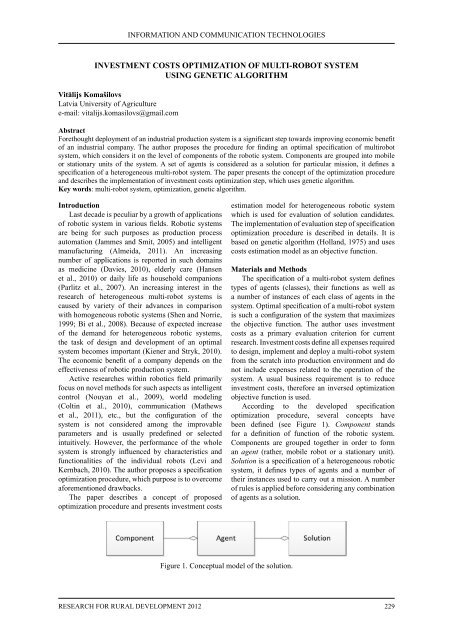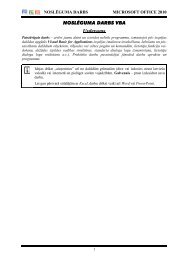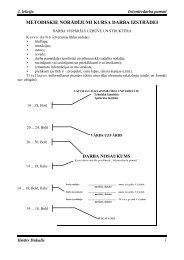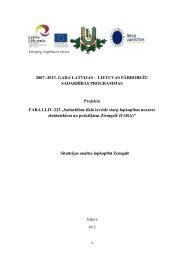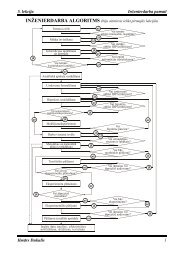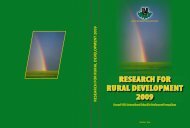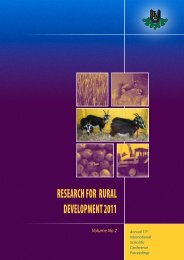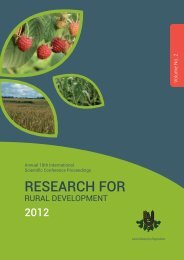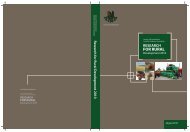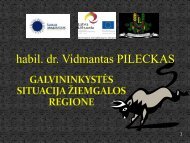LATVIA UNIVERSITY OF AGRICULTURE - Latvijas ...
LATVIA UNIVERSITY OF AGRICULTURE - Latvijas ...
LATVIA UNIVERSITY OF AGRICULTURE - Latvijas ...
- No tags were found...
Create successful ePaper yourself
Turn your PDF publications into a flip-book with our unique Google optimized e-Paper software.
INFORMATION AND COMMUNICATION TECHNOLOGIESInvestment costs OPTIMIZATION of MULTI-robot systemusing genetic algorithmVitālijs KomašilovsLatvia University of Agriculturee-mail: vitalijs.komasilovs@gmail.comAbstractForethought deployment of an industrial production system is a significant step towards improving economic benefitof an industrial company. The author proposes the procedure for finding an optimal specification of multirobotsystem, which considers it on the level of components of the robotic system. Components are grouped into mobileor stationary units of the system. A set of agents is considered as a solution for particular mission, it defines aspecification of a heterogeneous multi-robot system. The paper presents the concept of the optimization procedureand describes the implementation of investment costs optimization step, which uses genetic algorithm.Key words: multi-robot system, optimization, genetic algorithm.IntroductionLast decade is peculiar by a growth of applicationsof robotic system in various fields. Robotic systemsare being for such purposes as production processautomation (Jammes and Smit, 2005) and intelligentmanufacturing (Almeida, 2011). An increasingnumber of applications is reported in such domainsas medicine (Davies, 2010), elderly care (Hansenet al., 2010) or daily life as household companions(Parlitz et al., 2007). An increasing interest in theresearch of heterogeneous multi-robot systems iscaused by variety of their advances in comparisonwith homogeneous robotic systems (Shen and Norrie,1999; Bi et al., 2008). Because of expected increaseof the demand for heterogeneous robotic systems,the task of design and development of an optimalsystem becomes important (Kiener and Stryk, 2010).The economic benefit of a company depends on theeffectiveness of robotic production system.Active researches within robotics field primarilyfocus on novel methods for such aspects as intelligentcontrol (Nouyan et al., 2009), world modeling(Coltin et al., 2010), communication (Mathewset al., 2011), etc., but the configuration of thesystem is not considered among the improvableparameters and is usually predefined or selectedintuitively. However, the performance of the wholesystem is strongly influenced by characteristics andfunctionalities of the individual robots (Levi andKernbach, 2010). The author proposes a specificationoptimization procedure, which purpose is to overcomeaforementioned drawbacks.The paper describes a concept of proposedoptimization procedure and presents investment costsestimation model for heterogeneous robotic systemwhich is used for evaluation of solution candidates.The implementation of evaluation step of specificationoptimization procedure is described in details. It isbased on genetic algorithm (Holland, 1975) and usescosts estimation model as an objective function.Materials and MethodsThe specification of a multi-robot system definestypes of agents (classes), their functions as well asa number of instances of each class of agents in thesystem. Optimal specification of a multi-robot systemis such a configuration of the system that maximizesthe objective function. The author uses investmentcosts as a primary evaluation criterion for currentresearch. Investment costs define all expenses requiredto design, implement and deploy a multi-robot systemfrom the scratch into production environment and donot include expenses related to the operation of thesystem. A usual business requirement is to reduceinvestment costs, therefore an inversed optimizationobjective function is used.According to the developed specificationoptimization procedure, several concepts havebeen defined (see Figure 1). Component standsfor a definition of function of the robotic system.Components are grouped together in order to forman agent (rather, mobile robot or a stationary unit).Solution is a specification of a heterogeneous roboticsystem, it defines types of agents and a number oftheir instances used to carry out a mission. A numberof rules is applied before considering any combinationof agents as a solution.Figure 1. Conceptual model of the solution.Research for Rural Development 2012229


